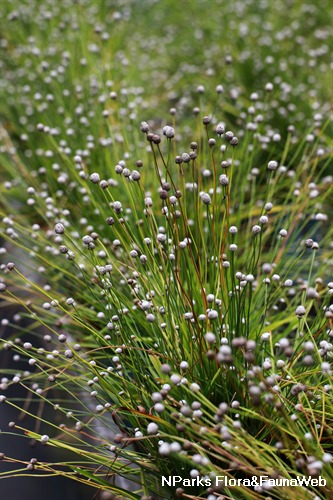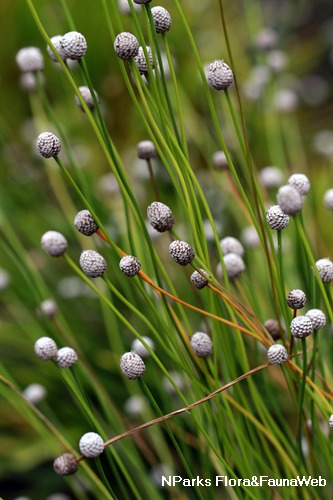
Back
Eriocaulon buergerianum Körn.
| Family Name: | Eriocaulaceae |
| Synonyms: | Eriocaulon chishingsanensis C. E. Chang, Eriocaulon pachypetalum Hayata, Eriocaulon whangii Ruhland |
| Common Name: | 谷精草 |
Name
Classifications and Characteristics
| Plant Division | Angiosperms (Flowering Seed Plants) |
|---|---|
| Plant Growth Form | Grass or Grass-like Plant |
| Lifespan (in Singapore) | Perennial |
| Mode of Nutrition | Autotrophic |
Biogeography
| Native Distribution | China, Taiwan, Japan and Korea. |
|---|---|
| Native Habitat | Aquatic (Freshwater Pond / Lake / River) |
| Local Conservation Status | Non-native |
Description and Ethnobotany
| Growth Form | A herb, it can grow emersed in water. |
|---|---|
| Foliage | The leaves are linear and measure 4 to 10cm long. |
| Flowers | The flowers are arranged on sub-globose, white coloured heads (inflorescence) which are held up by a scape up to 25 to 30cm tall. The inflorescence measures 3 to 5mm wide and 4 to 5mm high. The make and female flowers are borne on the same head. |
| Fruit | The seeds are sub-globose, measuring between 0.8 to 1mm. |
| Habitat | It is found in fields and marshlands at altitudes of 500 to 1300m. |
Landscaping Features
| Desirable Plant Features | Ornamental Form |
|---|---|
| Landscape Uses | Pond / Lake / River, Marsh / Bog |
| Thematic Landscaping | Water Garden |
Plant Care and Propagation
| Light Preference | Full Sun |
|---|---|
| Water Preference | Lots of Water |
| Rootzone Tolerance | Waterlogged Soils |
| Propagation Method | Seed |
Floral (Angiosperm)
| Flower & Plant Sexuality | Unisexual Flowers |
| Flower Colour(s) | White |
|---|---|
| Flower Grouping | Cluster / Inflorescence |
| Flower Location | Terminal |
| Inflorescence Type | Head / Capitulum |
Image Repository
Others
| Master ID | 32016 |
|---|---|
| Species ID | 6418 |
| Flora Disclaimer | The information in this website has been compiled from reliable sources, such as reference works on medicinal plants. It is not a substitute for medical advice or treatment and NParks does not purport to provide any medical advice. Readers should always consult his/her physician before using or consuming a plant for medicinal purposes. |

